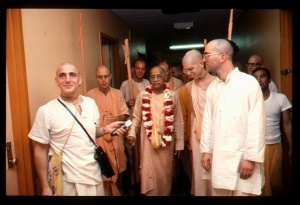SB 1.6.29 (1962): Difference between revisions
(Created page with '<div style="float:left">'''Goto SB 1.6.29 Current Edition'''</div> <div style="float:right">link='''SB 1.6.28 (1962) - - - [[SB 1.6.30 …') |
(Vanibot #0020: VersionCompareLinker - added a link to the Version Compare feature) |
||
| Line 1: | Line 1: | ||
<div style="float:left">'''[[SB | [[Category:Srimad-Bhagavatam (1962-1965) - Canto 01 Chapter 06]] | ||
<div style="float:right">[[File:Go-previous.png|link=]]'''[[SB 1.6.28 (1962)]] | <div style="float:left">[[File:Go-previous.png|link=SB (1962) Sixth Chapter - Conversation Between Narada & Vyasa]] '''[[SB (1962) Sixth Chapter - Conversation Between Narada & Vyasa]]'''</div> | ||
<div style="float:right">[[File:Go-previous.png|link=SB 1.6.28 (1962)]] '''[[SB 1.6.28 (1962)]] - [[SB 1.6.30 (1962)]]''' [[File:Go-next.png|link=SB 1.6.30 (1962)]]</div> | |||
{{CompareVersions|SB|1.6.29|SB 1962|SB 1972-77}} | |||
{{RandomImage}} | {{RandomImage}} | ||
| Line 6: | Line 8: | ||
==== TEXT No. 29 ==== | ==== TEXT No. 29 ==== | ||
<div class="SB65verse"> | |||
Kalpanta idam adaya shayane ambhasi udanwatah | |||
Shishaisor anupranam vivishe antar aham vibhoh, | |||
</div> | |||
==== ENGLISH SYNONYMS ==== | ==== ENGLISH SYNONYMS ==== | ||
<div class="synonyms"> | |||
<div | |||
Kalpanta—at the end of Brahma's one day, Idam—this, Adaya—taking together, Shayane—having gone to lie down, Ambhasi—in the causal water, Udanwatah—devastation, Shishoisor—lying of the Personality of Godhead, (Narayana), Anupranam—breathing, Vivishe—entered into, Antar—within, Aham—I, Vibhoh—of the Lord Brahma, | Kalpanta—at the end of Brahma's one day, Idam—this, Adaya—taking together, Shayane—having gone to lie down, Ambhasi—in the causal water, Udanwatah—devastation, Shishoisor—lying of the Personality of Godhead, (Narayana), Anupranam—breathing, Vivishe—entered into, Antar—within, Aham—I, Vibhoh—of the Lord Brahma, | ||
</div> | </div> | ||
| Line 22: | Line 23: | ||
==== TRANSLATION ==== | ==== TRANSLATION ==== | ||
<div class="translation"> | |||
<div | |||
At the end of millennium when the Lord Personality of Godhead Narayana lie down within the water of devastation, at that time when Brahma began to enter into Him along with all creative elements, I also entered within through his breathing. | At the end of millennium when the Lord Personality of Godhead Narayana lie down within the water of devastation, at that time when Brahma began to enter into Him along with all creative elements, I also entered within through his breathing. | ||
</div> | </div> | ||
| Line 30: | Line 30: | ||
==== PURPORT ==== | ==== PURPORT ==== | ||
<div class="purport"> | |||
<div | |||
Narada is known as the son of Brahma as much as Lord Krishna is the son of Vasudeva. The Personality of Godhead and His liberated devotees like Narada appear in the material world by the same process. As is said in the Bhagwat Geeta that the birth and activities of the Lord are all transcendental. Therefore, according to authorised opinion the birth of Narada as the son of Brahma is also a transcendental pastime of the devotee. His appearance and disappearance are practically on the same level as that of the Lord. The Lord and His devotees are therefore simultaneously one and different as spiritual entities. They belong to the same category of transcendence. | Narada is known as the son of Brahma as much as Lord Krishna is the son of Vasudeva. The Personality of Godhead and His liberated devotees like Narada appear in the material world by the same process. As is said in the Bhagwat Geeta that the birth and activities of the Lord are all transcendental. Therefore, according to authorised opinion the birth of Narada as the son of Brahma is also a transcendental pastime of the devotee. His appearance and disappearance are practically on the same level as that of the Lord. The Lord and His devotees are therefore simultaneously one and different as spiritual entities. They belong to the same category of transcendence. | ||
</div> | </div> | ||
<div style="float:left"> | <div style="float:left">'''[[SB 1.6.29|(Compare SB 1.6.29 Current Edition)]]'''</div> | ||
<div style="float:right">'''[[SB 1.6.30 (1962)]]'''[[File:Go-next.png|link=SB 1.6.30 (1962)]]</div> | <div style="float:right">[[File:Go-previous.png|link=SB 1.6.28 (1962)]] '''[[SB 1.6.28 (1962)]] - [[SB 1.6.30 (1962)]]''' [[File:Go-next.png|link=SB 1.6.30 (1962)]]</div> | ||
__NOTOC__ | __NOTOC__ | ||
__NOEDITSECTION__ | |||
Latest revision as of 11:37, 25 May 2020

A.C. Bhaktivedanta Swami Prabhupada
TEXT No. 29
Kalpanta idam adaya shayane ambhasi udanwatah Shishaisor anupranam vivishe antar aham vibhoh,
ENGLISH SYNONYMS
Kalpanta—at the end of Brahma's one day, Idam—this, Adaya—taking together, Shayane—having gone to lie down, Ambhasi—in the causal water, Udanwatah—devastation, Shishoisor—lying of the Personality of Godhead, (Narayana), Anupranam—breathing, Vivishe—entered into, Antar—within, Aham—I, Vibhoh—of the Lord Brahma,
TRANSLATION
At the end of millennium when the Lord Personality of Godhead Narayana lie down within the water of devastation, at that time when Brahma began to enter into Him along with all creative elements, I also entered within through his breathing.
PURPORT
Narada is known as the son of Brahma as much as Lord Krishna is the son of Vasudeva. The Personality of Godhead and His liberated devotees like Narada appear in the material world by the same process. As is said in the Bhagwat Geeta that the birth and activities of the Lord are all transcendental. Therefore, according to authorised opinion the birth of Narada as the son of Brahma is also a transcendental pastime of the devotee. His appearance and disappearance are practically on the same level as that of the Lord. The Lord and His devotees are therefore simultaneously one and different as spiritual entities. They belong to the same category of transcendence.